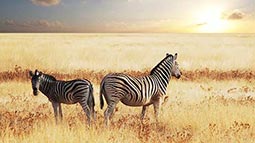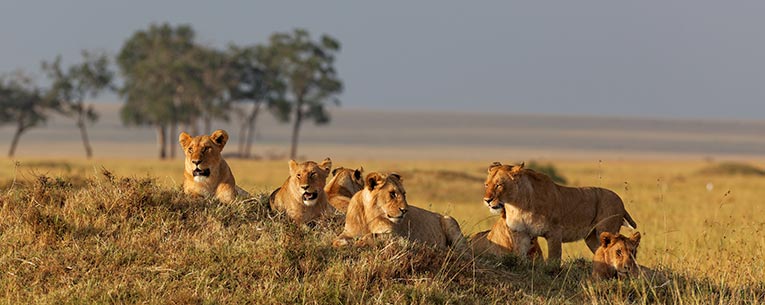Just saying the word “Serengeti” evokes the wonders of the African savannah: prowling lions, ambling elephants, thundering herds of wildebeest. This special place in Tanzania is one of the world’s best places to see wildlife, including the so-called Big Five: rhinoceros, elephant, buffalo, lion and leopard.
Serengeti is not only a national park but a region, encompassing the Ngorongoro Conservation Area, Maswa Game Reserve, the Loliondo, Grumeti and Ikorongo Controlled Areas and the Maasai Mara National Reserve in Kenya. All told, that’s more than 11,500 square miles. As you embark on your explorations, remember the keys to a successful safari: choose a reputable operator, get up early in the morning, and treat the wildlife — and your fellow humans — with respect.
What to Do in the Serengeti
In Serengeti National Park, the main attraction is The Great Migration: the movement of more than a million wildebeest, zebras and other grazing animals through the park on their way to greener pastures. The Great Migration isn’t a brief event; it takes place over several months. Following the rains, the animals head south every October and November, then head north and west in April through June.1
You don’t have to time your Serengeti trip around the Great Migration, however. There are many areas, like the Seronera River Valley, where animals (and tourists) are abundant year-round. Renting a Land Rover to explore on your own is not recommended, however. The best way to see the Serengeti is to hire a knowledgeable safari guide. Well-known safari destinations include the Retina Hippo Pool, where hundreds of the roly-poly animals wallow, and the Grumeti River, where giant crocodiles stalk migrating wildebeests.
If you’re interested in prehistory, consider visiting the Ngorongoro Crater and the Oldupai (Olduvai) Gorge, where paleontologists Louis and Mary Leakey found ancient fossils that were then the oldest evidence of human evolution. As of 2016, the discovery is commemorated by a small museum; a larger one is being planned.
Ngorongoro Crater
Of all the wonderful things to do in the Serengeti, hunting is not one of them. A U.S. investigation found in June that trophy hunting fees are not helping preserve threatened species, and concluded “that trophy hunting may be contributing to the extinction of certain animals.” 2
Where to Stay in the Serengeti
Whether you prefer grit or glamping, there’s a Serengeti lodge that’s just right for you. “If you're visiting in the winter, stay in the southern plains, and between July and November, set up camp in Central Serengeti, the Western Corridor or Northern Serengeti,” U.S. News advises.
The eastern grasslands were closed to tourists for 20 years to allow cheetah populations to rebound. Now, the big cats are back, and Namiri Plains is the place to see them. For $430-$935 per person, per night, you stay in a tented suite with panoramic views of the plains. Relax under a giant acacia and watch wildlife wandering nearby.
One of the best-known high-end lodges in Serengeti is Buffalo Luxury Camp, located just outside the park. Expect elegance: large, split-level tents with every amenity and a comfortably furnished lounge where you can enjoy a sundowner cocktail. Highlights include visiting local Maasai tribespeople and taking nighttime drives in search of aardvarks, hyenas and hunting lions.
Maasai man
Budget accommodations are available in the Serengeti, too. Look for an “overlanding” safari company, which means you’ll join a small group and assist with setting up camp, preparing meals and other chores. Serengeti Pride offers a budget camping option, in which guests stay at public campgrounds but enjoy the services of a chef and a guide.
When you’re traveling to a remote area like the Serengeti, it’s crucial to protect yourself with travel insurance from Allianz Partners. The OneTrip Premier Plan is an excellent choice for safari-style adventure travel, with up to $50,000 in emergency medical coverage and up to $1 million in emergency medical transportation. Also, kids 17 and under are covered free when traveling with a parent or grandparent (not available on policies issued to Pennsylvania residents). Get a quote today.
What Do I Need to Travel to the Serengeti?











Share this Page